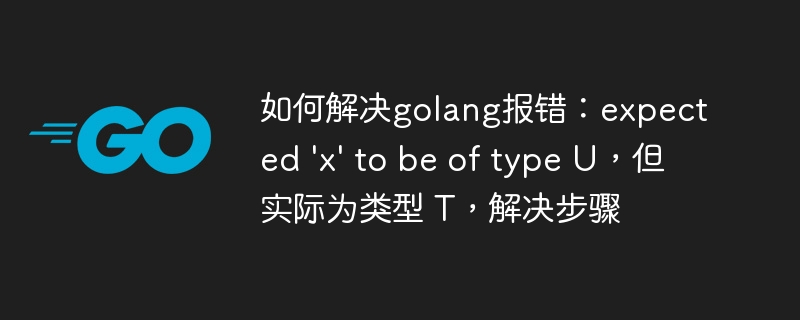Home >Backend Development >Golang >How to solve golang error: expected 'x' to be of type U, but actually type T, solution steps
How to solve golang error: expected 'x' to be of type U, but actually type T, solution steps
- WBOYWBOYWBOYWBOYWBOYWBOYWBOYWBOYWBOYWBOYWBOYWBOYWBOriginal
- 2023-08-25 17:05:031200browse

How to solve golang error: expected 'x' to be of type U, but actually type T, solution steps
Introduction:
Programming with Golang Language, we sometimes encounter some type error problems. One of the common problems is the error: "expected 'x' to be of type U, but actually type T" (expected 'x' to be of type U, but got T). This error often occurs when writing code, mainly due to variable or function return type mismatch. So, when we encounter this type of error, how should we solve it? This article will provide you with some troubleshooting steps and comes with code examples.
Error interpretation:
In Golang, type errors are a common problem. This error usually occurs when the type returned by a variable or function does not match the expected type. When we see the error message "expected 'x' to be of type U, but actually of type T", it means that we expected the variable 'x' to be of type U, but in fact its type is T. In order to solve this problem, we need to carefully examine the code and find out what is causing the type mismatch.
Solution steps:
The following are the steps to solve Golang type errors:
- Check the error message carefully:
When we encounter a type error, we should first check carefully Error message. The expected type and actual type will be displayed in the error message, which helps us locate the problem. -
Check the declaration and assignment of variables:
If the error message shows that the type of a variable does not match the expected type, we should check the declaration and assignment statements of the variable. Make sure that the correct type is specified when the variable is declared and that the type does not change during subsequent use.Sample code:
var x U x = someFunction() // someFunction()的返回类型应与U相匹配
-
Check the return type of the function:
If the error message shows that the return type of a function does not match the expected type, we should Check the function's return statement. Make sure the value returned by the function matches the expected type.Sample code:
func someFunction() T { // 函数返回的类型应为T // 函数体 } -
Check the parameter type of the function:
If the error message shows that the parameter type of a function does not match the expected type, we should Check the parameter list of the function. Make sure that the function's parameter types match those passed when calling the function.Sample code:
func someFunction(x U) { // 参数x的类型应为U // 函数体 } -
Use type conversion:
If we are sure that the type of a variable is correct, but we still get an error when using it, we can try Use type conversion. However, it should be noted that type conversion may introduce other problems, so use it with caution.Sample code:
var x U x = U(someFunction()) // 将someFunction()的返回类型转换为U
- Use IDE tools:
If the above steps still cannot solve the problem, we can use the automatic completion and type checking functions of the IDE tool to update Efficiently locate and resolve type errors.
Summary:
When writing Golang code, we often encounter the problem of type errors. When the error message "expected 'x' to be of type U, but actually type T" appears, we should check the code carefully and follow the above steps to solve the problem. Although resolving type errors may take some time, they are also one of the common problems in programming. Through careful inspection and debugging, we can better understand and master Golang's type system.
The above is the detailed content of How to solve golang error: expected 'x' to be of type U, but actually type T, solution steps. For more information, please follow other related articles on the PHP Chinese website!

